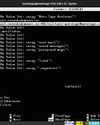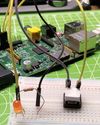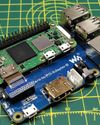How to recreate the Doctor Who theme
Linux Format
|October 2020
Mike Bedford makes use an analogue synthesiser simulator to generate one of TV’s most iconic and recognisable themes.

Established in 1958, the Radiophonic Workshop was created, according to the BBC, to produce incidental sounds and new music for radio and television. It was known for its pioneering work in electronic music and music technology.
Just two years into the Workshop’s existence, Delia Derbyshire, who had recently graduated from Cambridge with a degree in music and mathematics, joined the BBC as a trainee assistant studio manager. Within a couple of years she’d been assigned to the Radiophonic Workshop. It was here that she famously produced the Doctor Who theme tune, which had been composed by Ron Grainer.
Delia had to use a mix of equipment including laboratory instruments like signal generators, in-house designed and built electronic circuits, and reel-to-reel tape recorders. Bizarrely, Delia even used metal panels, specifically blanking plates from 19-inch instrument racks, plucked by hand, to create the twang of the Doctor Who baseline. To produce different notes, the sound was recorded on a tape recorder and played back at different speeds to alter the frequency, and further electronically manipulated to subtly alter the fundamental sound.
Introducing amSynth
We’ll be using a real-time open-source software synthesiser called amSynth, which is similar to classic analogue synthesisers of the 1970s, including the Minimoog and the Roland Juno-60. First install it on your PC and fire it up. Now click the Audition button towards the right-hand edge of the toolbar (which is a green forward-pointing arrow in some versions) and you’ll hear a musical note. What’s more, just by chance, unless they’ve been changed since the version we used, the default settings produce a sound that isn’t a million miles from what we need for the bass line of the opening few bars of the
このストーリーは、Linux Format の October 2020 版からのものです。
Magzter GOLD を購読すると、厳選された何千ものプレミアム記事や、10,000 以上の雑誌や新聞にアクセスできます。
すでに購読者ですか? サインイン
Linux Format からのその他のストーリー

Linux Format
Create your first WebSocket service
Mihalis Tsoukalos explains how to use the Go programming language to work with the WebSocket protocol.
9 mins
April 2023

Linux Format
Fantastic Mr Firefox
Nick Peers takes a trip down memory lane to reveal the story behind the rise - and slight fall - of Mozilla's popular web browser.
9 mins
April 2023

Linux Format
Set up your terminal and email like it's 1983
Jump in the hot terminal time machine with Mats Tage Axelsson who emails from the command line using the latest technology.
8 mins
April 2023

Linux Format
Universal layer text effects with GIMP
Posters use them, films and presentations are hard to imagine without them: text effects. Attract attention with Karsten Günther and GIMP.
8 mins
April 2023

Linux Format
Jump to a federated social network
Nick Peers reveals how you can get up and running with this free, decentralised and non-profit alternative to Twitter.
9 mins
April 2023

Linux Format
Free our SOFTWARE!
Taking anything for granted is dangerous, so Jonni Bidwell and Mike Saunders revisit how the free software movement got started to help free us from proprietary tyranny!
4 mins
April 2023

Linux Format
Master RPI.GPIO
Les Pounder goes back to the early days of the Raspberry Pi - and his career with this classic library! -
5 mins
April 2023

Linux Format
Waveshare Zero to Pi3
Transform your Pi Zero into a Pi 3, they promised Les Pounder, but it's more like adding on go-faster stripes.
2 mins
April 2023

Linux Format
The Best OPEN SOURCE Software Ever!
In an attempt to trigger controversy, Michael Reed and Neil Mohr unequivocally state these are the greatest free software apps ever. Probably. We’re just trying to be helpful.
19 mins
April 2023

Linux Format
Linux-Mandrake 7
Simplicity and a wide range of applications make this a great distribution for all Linux users.
2 mins
April 2023
Translate
Change font size

